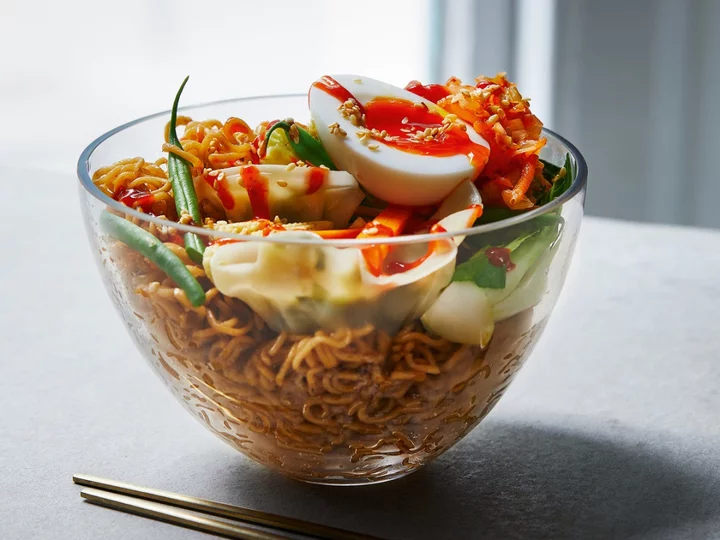
Vitamin D intake ‘may reduce cancer mortality in the population by 15%’ – study
Taking regular Vitamin D supplements may reduce cancer deaths in the population by 15%, according to scientists. Data gathered from the UK Biobank, an online database of medical and lifestyle records of around 500,000 Britons, indicates vitamin D deficiency is linked to an increased cancer mortality risk – particularly in relation to bowel, stomach, prostate, and lung cancers. The researchers said their work, published in Elsevier’s European Journal of Cancer, adds to evidence that vitamin D may have a protective effect against cancer. While the findings do not explain why this happens, the team said one possibility is that vitamin D supplements may induce anti-inflammatory, antioxidant, and DNA damage repair mechanisms, which can thwart mutations that allows tumours to grow. Study author Ben Schottker, an epidemiologist at the German Cancer Research Centre, said: “Our findings identified a statistically significant relationship between vitamin D deficiency and increased mortality among several cancers. “These results can be explained by other studies, which found mechanisms by which vitamin D inhibits cancer growth and metastasis.” The NHS advice is that adults and children over four take a daily supplement containing 10 micrograms of vitamin D throughout the year. According to the Department of Health and Social Care, around one in six adults and almost 20% of children in the UK have vitamin D levels lower than government recommendations. Older people, the housebound and people from black and South Asian communities are more likely to have lower levels of vitamin D. Our findings identified a statistically significant relationship between vitamin D deficiency and increased mortality among several cancers Ben Schottker For the study, the researchers looked at data from more than 400,000 people aged 40–69. In-depth medical information was gathered through blood, urine and saliva samples. A short interview and a questionnaire as used to assess vitamin D consumption as well as lifestyle factors such as alcohol consumption, smoking. Follow-up data on health outcomes were gathered through NHS links as well as care data, cancer screening data, and disease-specific registers. Over a period of nearly 13 years, close to 13,000 people died of cancer. Results showed a majority of the study population had either vitamin D deficiency (21.1%) or insufficiency (34.4%) – used to describe low levels of vitamin D. Of the people involved in the study, only 4.1% regularly took a vitamin D supplement and 20.3% regularly took a multivitamin. Results showed that vitamin D supplement users had 15% lower total cancer mortality and 25% lower lung cancer mortality compared to those who did not take the supplement. The also found researchers found that those with vitamin D deficiency had 42% increased mortality for stomach, 27% for bowel, 24% for lung, and 36% for prostate cancers. Meanwhile those with vitamin D insufficiency were found to have 14% increased bowel cancer mortality and 19% increased lung cancer mortality. The scientists said that the potential to reduce cancer mortality by vitamin D supplementation in populations with low levels should be further explored in new research. Commenting on the study, Dr Jenna Macciochi, senior lecturer in immunology at the University of Sussex, said: “This study adds to the growing body of evidence on vitamin D and cancer. “Vitamin D plays multiple key roles in immune health and the immune system is part of the body’s cancer defence system. “With cancer rates rising and presenting a serious public health issue, its useful to have further insight into the role of vitamin D in the prevention of cancer.” But Dr Macciochi also cautioned that the Biobank data might not be diverse and representative of the whole of the UK population. Alex Ruani, doctoral researcher at University College London and chief science educator at The Health Sciences Academy – who was not involved in the study, said that the exact dosage taken by participants was not ascertained and the risk reduction was not the same for all cancers. She said: “This research doesn’t imply that taking vitamin D3 supplements will for sure lower your risk of death from cancer. “Supplementation may help with consistent vitamin D levels, whereas production from sunlight can be variable and dependent on weather, time of the day, exposure duration, being outdoors or indoors, protective UV wear or sunblock, and many other factors.” She added: “Common food sources of vitamin D3 include full-fat dairy, egg yolks, and fish. “Although toxicity is rare, there is an upper tolerable limit set in the UK, where vitamin D3 supplementation shouldn’t exceed 100 micrograms a day.”
1970-01-01 08:00

Men who cycle, jog or swim could cut risk of nine cancers – study
Male joggers, swimmers and cyclists could be cutting their risk of nine cancers, a new study suggests. Researchers found that men with good cardiorespiratory fitness are far less likely to go on to develop cancers of the head and neck, stomach, pancreas, liver, bowel, rectum, kidney, lung and oesophagus. Cardiorespiratory fitness refers to a person’s ability to do aerobic exercise, such as running, cycling and swimming for sustained periods, or even to climb stairs. The new study, published in the British Journal of Sports Medicine, saw experts from Sweden track just over a million men for an average of 33 years. The men involved in the study were conscripted to military service in Sweden between 1968 and 2005. At the start of their conscription the men underwent a battery of tests assessing a number of factors including their height, weight, blood pressure, muscle strength and cardiorespiratory fitness. During the follow-up period, about 84,000 developed cancer. Researchers found that, compared with those with low cardiorespiratory fitness, men with a higher level of cardiorespiratory fitness were: – 19% less likely to develop head and neck cancer.– 39% less likely to develop cancer of the oesophagus (food pipe).– 21% less likely to develop stomach cancer.– 40% less likely to have liver cancer.– 18% less likely to develop bowel cancer and 5% less likely to develop cancer of the rectum– 20% less likely to develop kidney cancer.– 42% less likely to develop lung cancer.– 12% less likely to develop pancreatic cancer. “These results could be used in public health policymaking, further strengthening the incentive for promoting interventions aimed at increasing [cardiorespiratory fitness] in youth,” the authors wrote. The researchers did find that higher cardiorespiratory fitness was linked to a slight (7%) increased risk of prostate cancer and a 31% increased risk of skin cancer. A previous study examining the same data set suggested the slight increase in risk for prostate cancer was not linked to a higher rate of aggressive prostate cancer or prostate cancer death, and could be attributable to increased screening. The authors suggested a higher skin cancer rate could be explained due to “higher UV exposure”. Read More Charity boss speaks out over ‘traumatic’ encounter with royal aide Ukraine war’s heaviest fight rages in east - follow live Why are wellbeing experts concerned about TikTok’s ‘lazy girl job’ trend? Red flags you might be missing about your child’s online safety Rumer Willis says she is ‘grateful’ to her body following birth of daughter
1970-01-01 08:00

Why are wellbeing experts concerned about TikTok’s ‘lazy girl job’ trend?
Have you clocked TikTok’s ‘lazy girl job’ trend? It’s all about prioritising work-life balance over a job that drains you dry. A ‘lazy girl job’ is one that pays well enough for you to live comfortably – but doesn’t need to define your entire self-worth and consume too much of your time and energy. On the surface, this all sounds quite healthy, a backlash to the always-on ‘hustle culture’ that’s become ingrained in the modern world. So, why are wellbeing experts concerned? Work-life balance isn’t lazy “Turning your back on hustle culture shouldn’t be deemed ‘lazy’,” Tina Woods, CEO of Business for Health, a business-led coalition focused on improving workforce health, told PA Media. “A healthy work-life balance should be encouraged, rather than shamed, and employees shouldn’t feel guilty or ashamed for prioritising their wellbeing and mental health over their work duties and workload.” So, it’s not so much the concept behind ‘lazy girl jobs’ that’s problematic. Rather, it’s the use of the word ‘lazy’ to describe somebody who works a reasonable number of hours and values their wellbeing, and the reasons we got to this point in the first place. Have we normalised overworking? There may be times when people need or choose to hustle, or devote a larger chunk of their time towards a particular goal. That’s not something we need to sweepingly demonise necessarily. “Just as we shouldn’t shame employees who do set boundaries in the workplace and [want] a healthy work-life balance, there will be some employees who enjoy ‘hustle culture’,” Woods added. “Ultimately, employees should have the choice and flexibility to work how they choose to.” What isn’t good though is how “overworking” has become “expected” as part of modern working culture, she explained. We’re seeing a growing culture of overworking being celebrated... Tina Woods, Business for Health CEO “Hustle culture has grown in popularity since the pandemic, with side hustles on the rise amongst employees, especially Gen Z. However, the notion of pushing yourself and putting your all into your work can cause both physical and mental effects. It can lead to a toxic working pattern and trigger stress and burnout, as well as physical ailments such as disrupted sleep patterns and exhaustion,” said Woods. “More often, we’re seeing a growing culture of overworking being celebrated and, in many situations, expected. Whether this presents itself through staying at the office late, or not taking a lunch break or annual leave, working tirelessly is being rewarded by some seniors, and it shouldn’t become the norm.” What does this mean for young women? The fact the trend has been centred on ‘girls’ is another point of consideration. “Traditionally, women and especially mothers have faced stigma in the workplace. This includes stigma around personality traits, maternity leave and women’s health. As a result, many female employees will feel the need to push themselves harder or work longer hours than their male peers,” said Woods. “Women and parents are more likely to report lower mental health, putting them more at risk for mental health conditions such as anxiety and depression. This, coupled with the pressure women may already feel at work and stigma, such as the latest ‘lazy girl job’ trend, means employers need to ensure they’re creating a supportive work culture and healthy environment.” Culture shift According to Woods, there is a responsibility for employers to drive cultural shifts towards a healthier approach to work with a focus on preventative measures, rather than waiting until employees are encountering problems such as burnout or chronic stress, and then responding. “Setting boundaries that lead to a healthy work-life balance is something that should be encouraged in the workplace. It’s clear that post-pandemic, the boundaries have become blurred, with many adapting to hybrid and remote working. However, this is an issue employers need to make a priority,” said Woods. “By doing so, workplaces will see higher levels of presenteeism, alongside boosted morale, engagement and productivity. In a tight labour market, attracting and retaining employees is also vital. Wellbeing plays a big role in that. “Policies such as ‘Permission to Pause’ can be really powerful in encouraging a healthy work-life balance. They give employees autonomy and the ability to stop and take some time for their wellbeing within the working day, without feeling guilty,” she added. “Perhaps, most importantly of all, employers need to listen and respond to the needs of their own workforce and sector, recognising there is no ‘one size fits all’ solution to health and wellbeing, because everyone is uniquely human. Business leaders, HR managers and line managers can work to better understand the needs of their workforce through pulse surveys, interviews, and open forums.” Read More Charity boss speaks out over ‘traumatic’ encounter with royal aide Ukraine war’s heaviest fight rages in east - follow live Red flags you might be missing about your child’s online safety Rumer Willis says she is ‘grateful’ to her body following birth of daughter Sugary cereals and yoghurts must remove child-friendly packaging – health group
1970-01-01 08:00

Tourist Arrivals to Japan Recover to 78% of Pre-Pandemic Levels
The number of foreign visitors to Japan topped 2 million for a second consecutive month in July, recovering
1970-01-01 08:00

Germany's Cabinet is set to approve a plan to liberalize rules on cannabis possession and sale
Germany’s Cabinet is set to approve a plan to liberalize rules on cannabis, setting the scene for the European Union’s most populous member to decriminalize possession of limited amounts and allow members of “cannabis clubs” to buy the substance for recreational purposes
1970-01-01 08:00

Do it for the Gram: Speedy but spectacular goat’s cheese linguine
This vibrantly green pasta recipe is one of my favourites in the book,” says Mimi Harrison, author of Beat The Budget. “Not only is it bright and Instagrammable, it’s also so delicious. The frozen spinach is reasonably priced and you don’t have to worry about it going off in the fridge. And the goat’s cheese provides creaminess, acidity and tang, all in one ingredient (hello, cost-effective!). “This is ideal for a speedy meal when you’re in a rush, or to serve to friends at a dinner party when you don’t want to spend half the night in the kitchen.” Goat’s cheese, spinach and basil linguine Serves: 5 Ingredients: 1 tbsp olive oil 1 onion, diced 500g linguine 3 garlic cloves, finely grated 160g frozen spinach 125g goat’s cheese 30g fresh basil Salt and pepper to taste Chilli flakes (optional) Method: 1. Set a non-stick pan over a medium heat and add the olive oil. Add the onion, season with salt and pepper and gently fry for four minutes. 2. Meanwhile, set a large pan of salted water over a medium heat and bring to a boil. Add the linguine and cook for two minutes less than the packet cooking time. 3. While the pasta is cooking and once the onions have softened, add the garlic to fry for a minute before adding the frozen spinach to the pan, along with 400 millilitres of the starchy pasta water. Increase the heat and cook the spinach and onion mix until the pasta is ready. 4. Add the spinach and onion mix to a blender with half of the goat’s cheese and the basil and blitz until smooth. 5. Drain the linguine and transfer back to the pan. Pour over the blended sauce and continue to cook over a low\medium heat. 6. After about two minutes, the sauce should thicken and coat the linguine. Serve with a sprinkle of any remaining goat’s cheese and a pinch of salt and pepper. Optionally, top with chilli flakes if you love a little heat. ‘Beat The Budget’ by Mimi Harrison (Ebury Press, £16.99). Read More The dish that defines me: Mallini Kannan’s baked honey-soy salmon Breakfast for dinner and four other things you should cook this week How to save money in the kitchen according to top chefs Money-saving chilli con carne that absolutely slaps with flavour How to pimp up your instant ramen (and save money) Where to find the best Guinness in London – and how to spot a bad one
1970-01-01 08:00

How to save money in the kitchen according to top chefs
As the cost-of-living crisis continues to bite, many of us are looking for ways to save money where we can. Food shops are one of the main things that have become more expensive in recent years – so are there any easy ways to save a bit of cash in the kitchen? Chefs are on hand to share their top money-saving tips… Make simple swaps Suzanne Mulholland, author of The Batch Lady: Cooking On A Budget (HQ, £22) recommends letting go of loyalty to brand names. For example, she says: “You’re not going to notice a difference in flour – yet it’s about a fifth of the price of a branded one.” Mulholland continues: “If you love to eat haddock, then buy hake instead. If you like to eat cod, buy coley instead – monkfish? Buy seacat. These are all very similar fishes, but they’re just not the most popular ones everybody else buys. “You wouldn’t actually notice the difference between eating a different type of fish, because hake is very much like haddock – yet because it’s not that popular, it’s half the price. It’s also locally sourced, because these are all British fish.” Maunika Gowardhan, author of Tandoori Home Cooking (Hardie Grant, £25), also advocates cost-effective swaps. “If it’s a chicken recipe, I normally use chicken thighs over chicken breasts,” she says. “It’s a cheaper cut of meat, and it’s a more flavourful cut of meat.” If you’re a keen baker, The Great British Bake Off’s Kim-Joy (Bake Me A Cat, Quadrille, £16.99) has a top tip for you. As butter “has become so much more expensive”, she recommends “using more vegetable oil in baking”. Make a plan “Most people are cooking blindly,” says chef Max La Manna (You Can Cook This!, Ebury Publishing, £22), “Pulling ingredients together and cooking – they do the same when they go to a supermarket, they buy ingredients – and a lot of waste happens when people don’t have a plan.” La Manna’s top tip is firstly “cook the food you already have before you go out and buy more”. After that, it’s all about making a plan. “Shop smarter,” says La Manna. “Create lists when you go to the supermarket, and stick to that list.” Make your ingredients last longer Throwing away produce that’s gone off is money down the drain – so La Manna is keen for us all to make ingredients last longer. “You can extend the shelf life of ingredients – for instance, most people throw away bag salad or herbs,” he says. “What I do with my bag salad, once I bring it home I’ll wash it and also let it sit in cold water – because it firms up and it gets crisp and it stays fresh a little longer.” Once he’s washed the salad, he divides the bag of leaves – putting half in a container in a tea towel (“to absorb some of the moisture”) and use within the next three or four days. “The other half I cook in hot water – blanch it really quickly, squeeze out the water, then I have this kind of pre-cooked spinach. Roll that up tightly, place it in the freezer and then when I need something in a week’s time – a stew, a soup, a curry, a stir-fry – pop those in.” You can also reduce waste by knowing how to store all your other produce properly. “That’s where a lot of waste is coming in, people put ingredients away, they turn their back and the food’s already gone bad,” says La Manna. “Know how to store your produce and where to store it – potatoes should be kept in a cupboard somewhere dry, dark, cool but well-ventilated so they don’t begin to sprout. Same thing with onions. Bananas like to have their own space – bananas don’t like to be with other ingredients, because they release a chemical and will ripen quicker.” Instead of throwing away bananas on the turn, La Manna says: “It’s great for the freezer, [or] use them in smoothies. Use them as a batter for cupcakes or cakes.” Use every part of your ingredients “With Chinese food, there really is a ‘no waste’ policy,” says Kwoklyn Wan (One Wok, One Pot, Quadrille, £16.99) – and he suggests this ethos could help you save money in the kitchen. “Even when you peel your onions, use the onion skin in the stock” – along with anything else you might normally throw away, such as the top ends of carrots or fish heads. “That’s so important – if people learn to use every part of that ingredient… You can have a fantastic dish with all the best bits, and at the end of it, you’ve got this fantastic soup base. All you’ve got to do is add really cheap noodles into it, and maybe a few veggies and tofu, some chicken – whatever. “You’ve got this lovely broth – and that’s your next meal completely free, or near enough.” Be smart with your ingredients Most of us are guilty of buying an exciting-sounding ingredient for our store cupboard and only using it once. If you really want to save money in the kitchen, it’s all about being smart with what you buy – and making sure you’re going to use it a lot. Lydia Vernon, co-author of Caught Snackin’ (Hamlyn, £20), says that on Caught Snackin’s wildly popular TikTok channel,”we like to keep with the same ingredients for each recipe. “We stay around things like mixed herbs, garlic powder, plain flour – those kind of staples you have in your cupboard all the time, which are going to be cost-effective.” Food writer Gurdeep Loyal (Mother Tongue, Fourth Estate, £26) takes this one step further, saying: “My advice would be to equip your pantry with four or five very flavour-forward ingredients – things such as tamarind paste, things such as brown miso, things such as fennel seeds, for example, or something like tandoori masala powder. “Because these four or five pantry staples can transform anything really simple and basic – just adding a spoonful of this is going to amplify your cooking into hundreds of different directions. “It means you can use very basic supermarket staples, then turn them into something incredible” – without having to spend money on fancy new ingredients every week. Read More The dish that defines me: Mallini Kannan’s baked honey-soy salmon Breakfast for dinner and four other things you should cook this week Money-saving chilli con carne that absolutely slaps with flavour How to pimp up your instant ramen (and save money) Do it for the Gram: Speedy but spectacular goat’s cheese linguine Where to find the best Guinness in London – and how to spot a bad one
1970-01-01 08:00

How to pimp up your instant ramen (and save money)
There is something so wonderfully comforting about a bowl of ramen noodles, whatever the season,” says chef and TV presenter Shivi Ramoutar, author of Cook Clever. “This version uses packet ramen – don’t turn your nose up at it; I assure you that with the added flavours, veg and protein, it becomes something spectacular and amazingly easy to accomplish. This is one to elevate to your heart’s content – you really can’t go too OTT with this. Have it slurpy or dry as you like.” Pimped packet ramen Serves: 2 Ingredients: For the base: 2 tbsp toasted sesame oil 1 spring onion (white bulb discarded), snipped 1 tsp garlic purée 2 mugs of boiling water 2 packets of ramen noodles (or any other instant noodles) OR 300g ready cooked noodles and 1 chicken stock cube, crumbled OR 300g ready cooked noodles and 2 sachets of miso soup mix For the protein (choose from): 1 mug of frozen, fresh or cooked chicken strips 1 mug of frozen, fresh or cooked seafood 1 mug of frozen or fresh gyoza dumplings ½ block of firm tofu, broken into smaller pieces For the veg: 250g packet of pak choi, leaves separated ½ mug of frozen vegetables Toppers (choose as many as you like): Soft-boiled egg halves Drizzles of chilli oil 1 tbsp sesame seeds Fresh coriander sprigs Fresh chillies Kimchi Drizzles of sriracha Method: 1. Heat the oil in a small saucepan over a medium heat and cook the spring onion and garlic purée for a couple minutes, stirring often until aromatic. 2. Add the boiling water, along with the dried noodles and their flavour sachets, or the cooked noodles with the crumbled stock cube or the miso soup sachets. Stir together and cook for a minute or two until the liquid is mostly absorbed. 3. Add your chosen protein and the veg and cook until the protein is just cooked through, about five minutes or so. If you are using fresh chicken or seafood it will take less time. If using tofu, add in the last few minutes so it doesn’t disintegrate. 4. Serve into bowls and go crazy with the toppers. ‘Cook Clever: One Chop, No Waste, All Taste’ by Shivi Ramoutar (HarperCollins, £20). Read More The dish that defines me: Mallini Kannan’s baked honey-soy salmon Breakfast for dinner and four other things you should cook this week How to save money in the kitchen according to top chefs Money-saving chilli con carne that absolutely slaps with flavour Do it for the Gram: Speedy but spectacular goat’s cheese linguine Where to find the best Guinness in London – and how to spot a bad one
1970-01-01 08:00

Money-saving chilli con carne that absolutely slaps with flavour
This is a versatile dish that you can pair with many different things; have it with rice, smother it over fries, put it on a hot dog, pour it over a jacket spud or just use it as a dip for tortilla chips,” says Mitch Lane, author of Feed Your Family For Under A Fiver. “It can be frozen as well, so it’s great for saving time while meal prepping! I use store-bought chilli con carne seasoning, but if you have a lot of spices in your cupboard (cumin, chilli powder, paprika, cumin seeds) then you’re on to a winner. This is so simple and it absolutely slaps with flavour.” Chilli con carne Serves: 4 Ingredients: 1 tsp vegetable or olive oil 1 onion, finely chopped 4 garlic cloves, finely chopped 2 green chillies, finely chopped, plus 1 to serve 500g minced beef 41g packet of chilli con carne seasoning 400g tin chopped tomatoes 130g tin kidney beans, drained 300ml beef stock (made with a stock cube) Salt and pepper Method: 1. Put a pan on a medium heat and add the oil and the onion and soften for three to four minutes. Add the garlic and chillies and continue to cook for a further two minutes. If you’re not keen on a lot of spice just use one chilli and remove the seeds. 2. Add the mince and break it up with the back of a spoon, ensuring that there’s no big lumps. Cook the meat until it’s nice and brown. Be generous with the salt and pepper and then add the chilli con carne seasoning. Mix well. 3. Add the tomatoes and kidney beans and stir. Then pour in the beef stock and simmer for 30 minutes. The simmering is very important (it’s like a fine wine that gets better with age). 4. Serve with sliced chilli. ‘Feed Your Family For Under A Fiver’ by Mitch Lane (Thorsons, £16.99). Read More The dish that defines me: Mallini Kannan’s baked honey-soy salmon Breakfast for dinner and four other things you should cook this week How to save money in the kitchen according to top chefs How to pimp up your instant ramen (and save money) Do it for the Gram: Speedy but spectacular goat’s cheese linguine Where to find the best Guinness in London – and how to spot a bad one
1970-01-01 08:00

Australia Rallies Behind Matildas for Crunch World Cup Match
Australia reached fever pitch ahead of its national team’s first appearance in a Women’s World Cup semi-final match,
1970-01-01 08:00

DeSantis' appointees ask judge to rule against Disney without need for trial
Gov. Ron DeSantis’ appointees to a board that oversees Walt Disney World say a Florida judge should rule without trial against Disney as the company fights Gov. Ron DeSantis’ takeover of the governing district
1970-01-01 08:00

Jessica Simpson reacts to Catherine Zeta-Jones wearing dress she wore 17 years ago
Catherine Zeta-Jones was spotted out in Portofino, Italy, hand-in-hand with her husband, Michael Douglas, wearing an ethereal, deep purple Emmanuel Ungaro gown. However, eagle-eyed fans noticed that pop star Jessica Simpson wore the exact same dress to VH1’s Big in ‘05 awards show, where coincidentally she was awarded for her sense of style. Although Zeta-Jones, 53, wore the dress in July, Simpson recently reacted to the actor’s glamourous look, saying on her Instagram Story: “Sexy never goes out of style.” It certainly wasn’t the first time two celebrities had a twinning moment. In the height of the ‘00s magazine era, outlets famously printed both photos of stars wearing the same outfit alongside the question: “Who wore it better?” While tabloids often pitted two women against each other, it was a sign of the times that Simpson supported and complimented the Oscar winner’s look. Glamour posted a side-by-side picture of both Simpson and Zeta-Jones’ looks to Instagram, sans comparison. Many users in the comments section were divided by the early aughts style of the dress. One commented that the dress looked “like a Gucci number,” while another wrote: “Could have stayed in 2005.” When Simpson originally wore the gown, she had recently finalised her divorce from Love Is Blind host Nick Lachey. According to Us Weekly, fans considered the sultry look a “revenge dress” back in the day. Since then, Simpson has become a mother of three and recently authored the best-selling memoir, Open Book, which has sold half a million copies worldwide. In the book, Simpson confided in readers about her struggles with alcoholism, weight loss, and relationships in the public eye. The singer also spoke about her eponymous fashion line, which includes apparel, shoes, hair extensions, and at one point, edible body products. Like Simpson, the Chicago star has also turned heads with her fashion looks. These days, she does so alongside her daughter - rising musician Carys Douglas, who goes by CZD professionally. The mother-daughter pair recently donned Elie Saab gowns to the Jeanne Du Barry premiere at the 76th annual Cannes Film Festival. While Zeta-Jones wore a deep, plunging red gown with a matching cape attached to one sleeve, all eyes were on her mini-me. For her red carpet debut, her daughter wore a gown made of a sheer lace fabric, coupled with netting detail near the hem of the skirt. She paired the look with a soft, rosy-cheeked makeup look that emphasised her youthful ensemble. Beside her mother, the budding singer watched as her father was awarded with the Lifetime Achievement Palme D’Or. She took to Instagram to post about the glamourous evening, writing: “Thank you Cannes for the most wonderful evening! It was an honor to celebrate my father as he received his lifetime achievement Palm D’Or. Bon festival!” Read More Jessica Simpson has subtle response to claims ex-husband Nick Lachey was ‘villain’ in their relationship Catherine Zeta-Jones compares daughter Carys to Wednesday Addams in throwback post Pharrell Williams designed his first collection for Louis Vuitton for himself TikToker urges parents to save all their old clothes for children to inherit Billy Porter criticised for calling Anna Wintour a ‘b****’ over Harry Styles cover
1970-01-01 08:00
